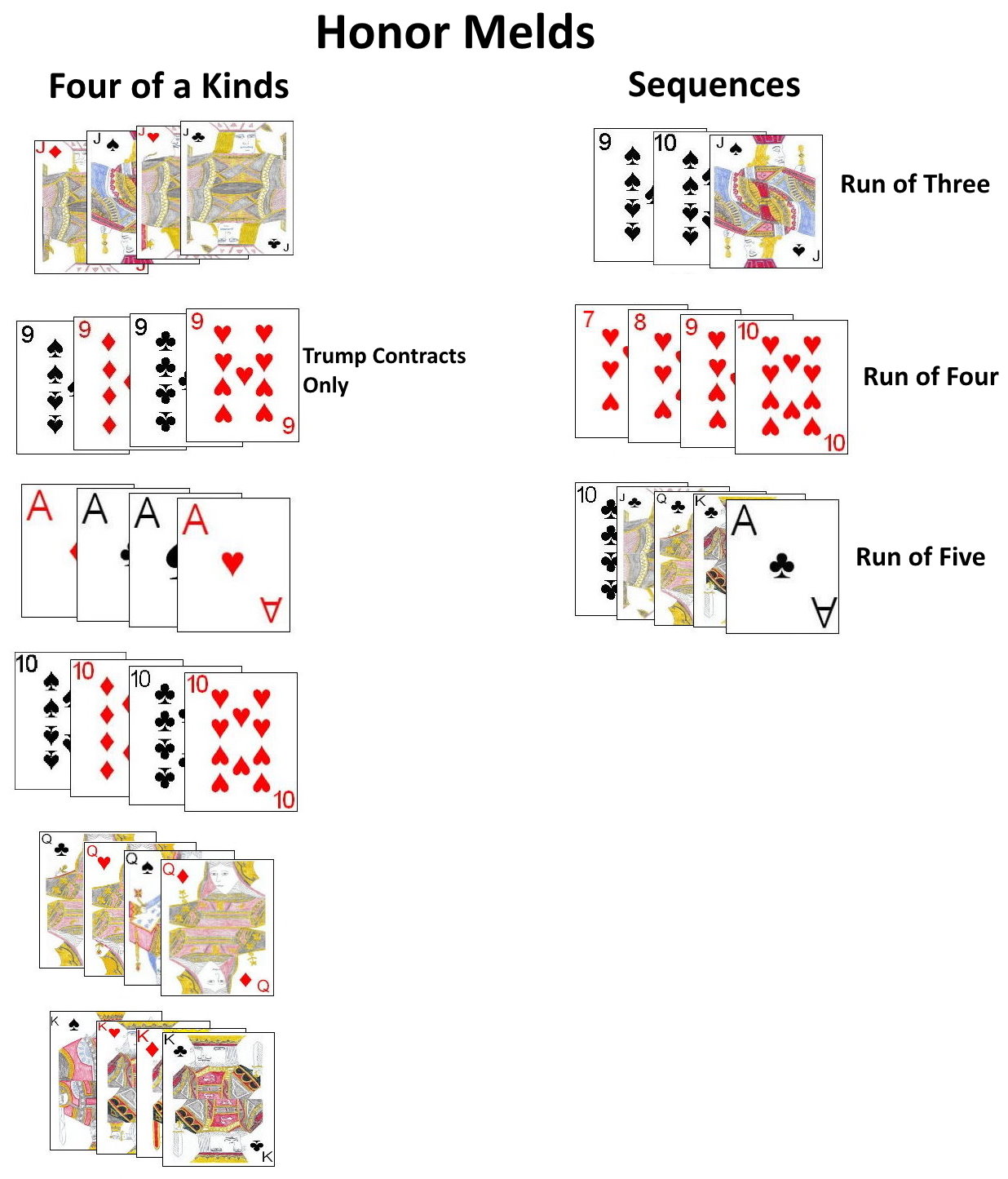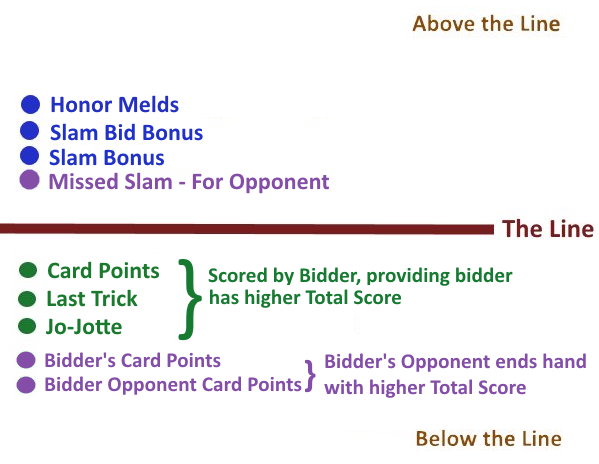|
 |
How to Play Jo-Jotte |
 After the first dealer has been determined, this player thoroughly shuffles the deck and offers it to his opponent to cut. After the cut, the dealer then deals each player six cards in two three card packets. He begins by dealing the first such packet to his opponent, and the next to himself. After each player has six total cards, he then places the remainder of the deck in the middle of the table, removing the top card from the deck and placing it beside the deck. This exposed card is called the turn-up card.
After the first dealer has been determined, this player thoroughly shuffles the deck and offers it to his opponent to cut. After the cut, the dealer then deals each player six cards in two three card packets. He begins by dealing the first such packet to his opponent, and the next to himself. After each player has six total cards, he then places the remainder of the deck in the middle of the table, removing the top card from the deck and placing it beside the deck. This exposed card is called the turn-up card.
 The first category is the Four of a Kind category. A four of a kind is four
cards all of the same denomination, in certain ranks (i.e. Four Aces). In a hand being played with a trump suit, a player may declare a four of a kind in the following ranks; Jacks, Nines, Aces, Tens, Kings, Queens. In a
contract of no trump, a player may declare a four of a kind of the following ranks; Aces, Tens, Kings, Queens, Jacks. Both players, starting with the non-dealer, announces his highest four of a kind (if he has any). The opponent may either concede the score to that player for the four of a kind or announce a higher ranked four of a kind (if he has one and wants to show it). The player with the highest four of a kind is then entitled to score for that four of a kind as well as any other applicable four of a kind combinations he has in hand. Any four of a kind honor melds which are scored must also be temporarily shown to the opponent. Each four of a kind scored earns that player 100 points.
For comparison of Four of a Kind type melds, in trump suit contracts, the
ranking uses the card ranking as in the trump suit, and for non trump suit
contracts the normal card ranking is used.
The first category is the Four of a Kind category. A four of a kind is four
cards all of the same denomination, in certain ranks (i.e. Four Aces). In a hand being played with a trump suit, a player may declare a four of a kind in the following ranks; Jacks, Nines, Aces, Tens, Kings, Queens. In a
contract of no trump, a player may declare a four of a kind of the following ranks; Aces, Tens, Kings, Queens, Jacks. Both players, starting with the non-dealer, announces his highest four of a kind (if he has any). The opponent may either concede the score to that player for the four of a kind or announce a higher ranked four of a kind (if he has one and wants to show it). The player with the highest four of a kind is then entitled to score for that four of a kind as well as any other applicable four of a kind combinations he has in hand. Any four of a kind honor melds which are scored must also be temporarily shown to the opponent. Each four of a kind scored earns that player 100 points.
For comparison of Four of a Kind type melds, in trump suit contracts, the
ranking uses the card ranking as in the trump suit, and for non trump suit
contracts the normal card ranking is used.
| Trivia: Ely Culbertson, the inventor of Jo-Jotte, named the game after his wife at the time, Josephine Culbertson. |
|
 |
 The summation of all these scores is called the Total Score. If the contractor for the hand has a higher "Total Score" than his opponent for the hand, he adds his trick score for the hand (his total points earned during the hand from cards won in tricks, last trick and Jo-Jotte) to his current below the line total, and his opponent adds his own Trick Score (all points earned from cards won in tricks, last trick and Jo-Jotte) to his above the line section of the
score sheet. However, if the defender has the higher Total Score for the hand, the defender scores his own Trick score added to the declarer's Trick score to his own below the line section of the
score sheet. If a "Double" call was made during the hand, however, the player with the higher Total Score, scores double the sum of both player's trick score to his below the line section of the
score sheet. If the contract was redoubled, the player with the higher total score, adds the sum of both scores, multiplied by four to his below the line section of the
score sheet.
The summation of all these scores is called the Total Score. If the contractor for the hand has a higher "Total Score" than his opponent for the hand, he adds his trick score for the hand (his total points earned during the hand from cards won in tricks, last trick and Jo-Jotte) to his current below the line total, and his opponent adds his own Trick Score (all points earned from cards won in tricks, last trick and Jo-Jotte) to his above the line section of the
score sheet. However, if the defender has the higher Total Score for the hand, the defender scores his own Trick score added to the declarer's Trick score to his own below the line section of the
score sheet. If a "Double" call was made during the hand, however, the player with the higher Total Score, scores double the sum of both player's trick score to his below the line section of the
score sheet. If the contract was redoubled, the player with the higher total score, adds the sum of both scores, multiplied by four to his below the line section of the
score sheet.